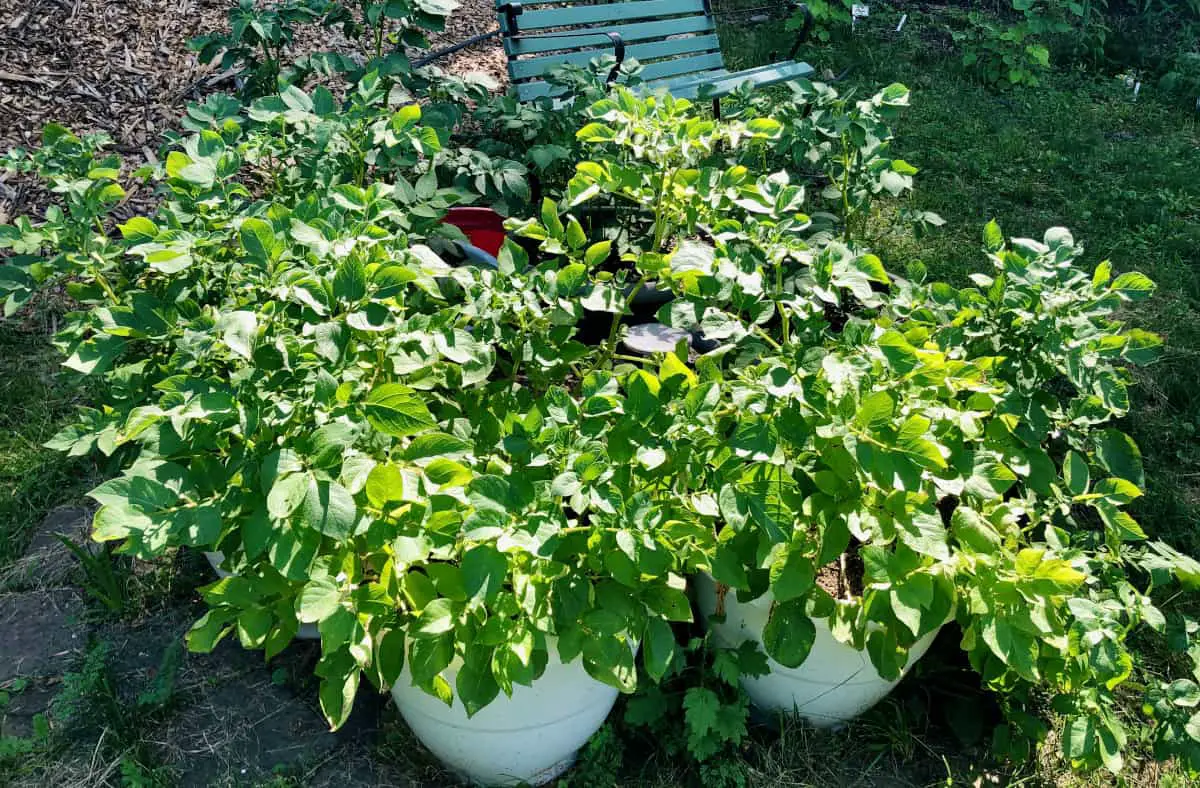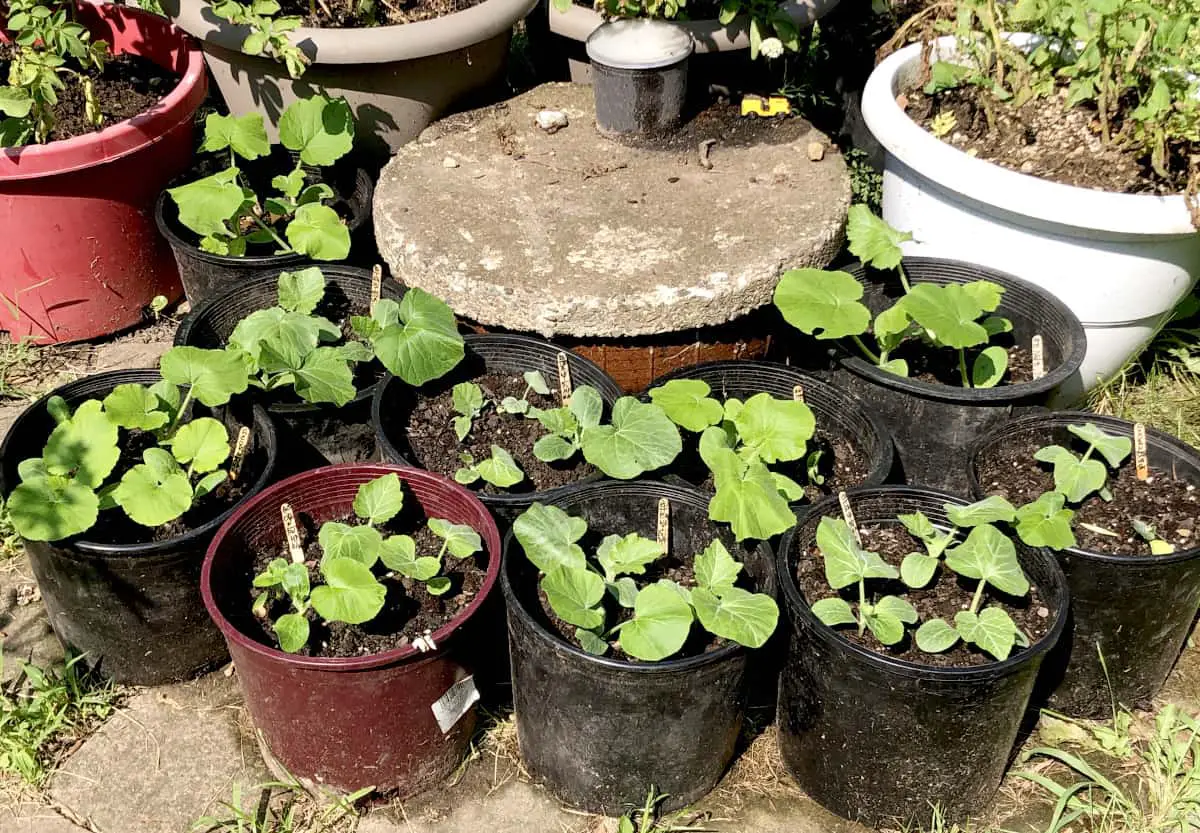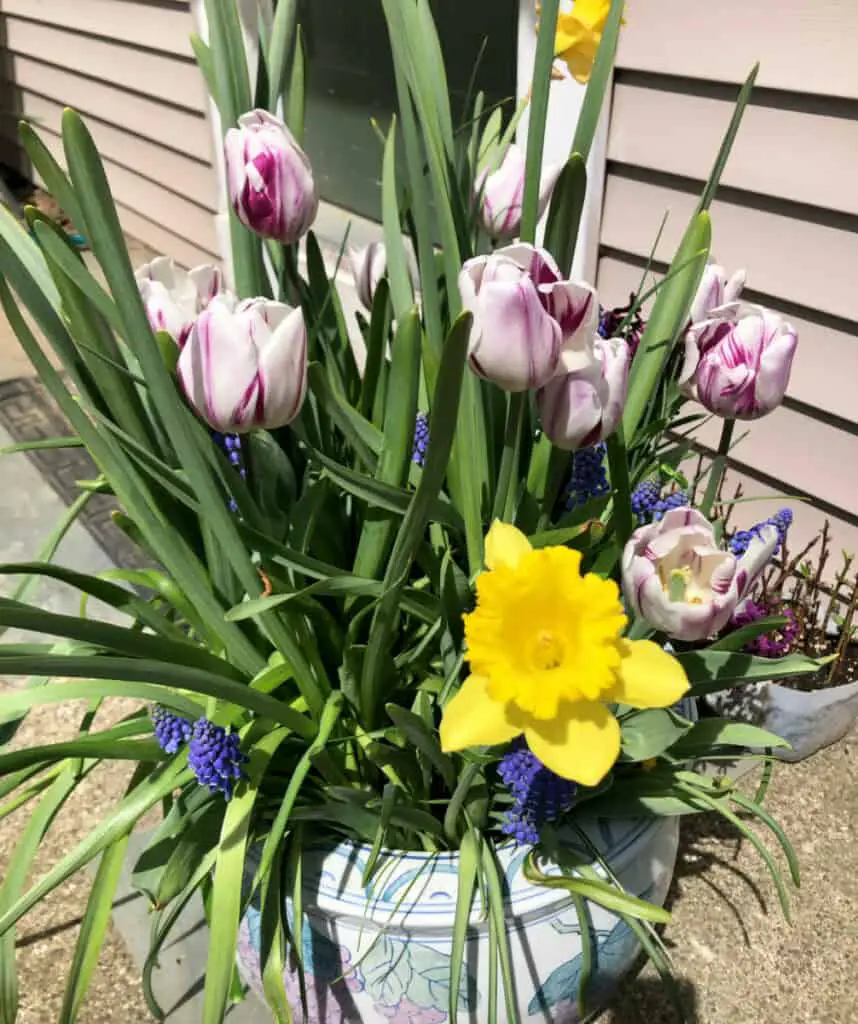In my growing space, I use to set up a container garden when I run out of space. A container garden can be a great extension to your already existing garden when you need more space to grow. I also set up containers in spots that need to be filled up, where I find gaps with no soil available, I fill the gap with a container. I also use containers to grow more invasive edible plants like mint. I grew mint directly in my garden before but it expanded too much so I decided to grow it in the pots instead to control it and to allow more space for other edibles.
To start a container garden for beginners:
- Choose the right sunny spot
- Measure the spot for the garden to know how many containers you need
- Get the containers and the soil.
- Make a list of fruit and vegetables you want to grow
- Prepare your supplies and place your containers in your growing space
- Moisten your soil and fill containers with it
- Plant your seedlings or sow your seeds, whichever you prefer
- Water your newly planted garden
- Provide each plant with the care it requires
Readers’ favorite and related: How to start a vegetable garden

How to choose the right spot for a container garden
The right spot for a container garden is a sunny location with at least 6 + hours of sun. Most vegetables and fruit need at least 6 hours of sunshine. If you can find a location with more than 6 hours of sun, even better. If possible, choose a location that is not exposed to much wind, is on the south side, or where the trees, buildings, fence, or other obstacles won’t cast a shadow into your garden to shade the plants. Ultimately use what you have got and choose the best location you can.
How to measure a container garden area
Use a measuring tape to measure the perimeter of your garden. Measure the length and the width of the area then multiply them together to get the square footage of your area. It looks like this, the length x the width=square footage. You just found out the square footage of your container garden to be. This will help you know how many containers you will need to fill up the space to its max.
Wonder what size of the garden to start with? Read here How small garden to start with.
What containers are best for a container garden?
The best containers for a container garden are the ones that are durable and will last you more than just one season. Choose planters you can reuse season after season, keep moisture in the soil but drain well. Some of the best and most popular containers for a container garden are fabric containers and planters, plastic containers, vertical gardens, stackable containers, self-watering containers, ceramic, clay planters, and wooden boxes. When choosing a container other than a grow fabric container make sure there are holes for the moisture to drain. If you like the container with no holes on the bottom, then drill the holes in the container before planting in it.
Some other options that can be used as containers are reusable grocery bags from recycled plastic, which are so easy to set up. Other options to use in a container garden are straw bales, old pots, kiddie plastic pools, laundry baskets, 5-gallon plastic buckets, troughs, or DIY cement pots.
How to choose the right size of container for a container garden?
Choosing the right size of containers for your container garden is crucial. Choose rather larger containers to provide plenty of space for the plant to grow healthy roots and to accommodate the size of a mature plant and fruit. larger containers will provide more space for more plants to grow together. Small containers will accommodate a smaller number of plants to grow and might soon become too small for the roots of the growing plant. The best size containers for a container garden are about 20-gallon pots. You will need to buy less of them but have a lot of space to grow a lot of crops.
What soil is best for a container garden
The best soil for a container garden is loamy soil that can drain well but hold a good amount of moisture. Potting mix with fertilizer already mixed in will work very well. If you prefer to mix your own soil mix, then mix 1 part of peat moss or coco coir with 1 part of perlite and 2 parts of compost. Mix well and moisten before filling your containers with the soil. Worm casting and other organic matter can be mixed in if you desire so.
What is the easiest vegetable to grow in pots?
The easiest vegetables to grow in pots are leafy greens like lettuce, and root vegetables like carrots, beets, and radishes. Nightshades like tomatoes, and peppers. Zucchini and peas are also good choices, along with fruit such as strawberries, blueberries, and herbs like basil, chives, dill, cilantro, thyme, and rosemary. In short, all vegetables can be grown in pots. Do not feel limited in what you can and cannot grow in your container garden. The larger the container, the more options you have. There are even fruit trees that can be grown in containers! To get the most out of your container garden choose high-yield vegetables such as carrots, garlic, tomatoes, peppers, zucchini, potatoes, cucumbers, beets, beans, spinach, arugula, and herbs. If you go with a long season growing vegetables then choose the ones that yield a lot because they will occupy your precious growing space for a long time. If you choose short-season growing vegetables that grow and yield fast, you can harvest them and plant them again multiple times per one growing season, meaning you will turn our growing space again and again which will result in more harvest.

If you want to fill your growing space to the max, you can grow some vegetables in clumps. I invite you to read my article where I talk about What vegetables are good for small spaces? and how to grow in clumps to save space.
If you need more guidance on how to choose vegetables most suitable for your space, then read and visit one of my readers’ favorite pots Vegetables that need very little space.
Most importantly, when planting any type of garden, is to choose vegetables that you and your loved ones will actually eat.
If you are looking for quick maturing vegetables to make the most of your container garden, read our post What vegetables can be harvested in one month?
What supplies are needed for a container garden
Supplies needed for the container garden are:
- Trowel
- Culti-hoe
- Pruner or garden shears
- Gardening gloves
- A watering can or a garden hose
- Kneeling pad
- Soil scoop, which you can buy or make your own, or use old pots to scoop the soil
Remember, you don’t have to purchase all the supplies. There are several ways to get your supplies for free. You can make some of them, such as plant labels like I make my own. Take a look at how I make my plant labels by clicking HERE. You can also repurpose other things like an old pot or cup for a soil scoop. Ask your family and friends for garden supplies as gifts. Family members always look for the best gifts for their loved ones. If you ask for garden supplies, they will be more than happy to gift them to you. Ask your friends, family, or social media groups for free garden supplies they no longer use. Many households are loaded with clutter they don’t use that can be useful to you.
How to fill containers in a container garden
The best is to fill containers in the container garden with a soil mix that is not too heavy in case you need to move some of the containers later on. The soil should drain well but keep a good amount of moisture. Since containers come in all shapes and sizes, if you have a larger container to fill and would like to save as much soil mix as possible, you can fill the bottom of a large container with the smaller empty upside-down turned pots to make up some space to save some the soil mix. The bottom can be filled with woodchips, twigs, shredded paper, straw, pine cones, toilette paper rolls, or simply organic matter that will slowly decompose. Put the bigger, chunkier stuff on the bottom first to ensure drainage. Kitchen scraps, grass clippings, and leaves can be used closer to the top. When you are about 10 inches to the top, fill the rest with the soil mix. Fill the container to the top as the soil will settle down as you water and overtime. Now your container is ready to receive seeds of seedlings.
When filling your containers with soil, moisten the soil before you fill the containers.

When and how to plant a seedling in containers
Dig a hole in the soil about as deep as the pot your seedling was at or about as deep as the plug is. Place the seedling in the soil and gently cover the roots with the soil. Water soil covered roots and fill in the rest of the hole with the soil. Tamp the surface of the soil and water thoroughly. Seedlings should be planted outdoors when the temperatures reach the recommended numbers. Seedlings of cold-weather crops can be planted even before the last frost date. But seedlings of warm-weather crops should be planted after the last frost date. Check the seedlings or packaging information for recommended planting dates.
Some gardeners like to add their favorite fertilizer to the bottom of the planting hole for extra fertilizer when planting out their seedlings.
If you are in need of more detailed information about the seedlings such as how big the seedlings should be before planting outdoors, how long should the seedling be in the seed trays, and how to prepare or harden off the seedlings, I invite you to read my readers’ favorite article When and how to plant a seedling.
When and how to water container garden
A container garden needs to be watered when the soil is dry couple inches below the surface. Stick the finger in the soil and feel the moisture around your finger. If the soil in the containers feels dry and crumbly it needs to be watered. Avoid quick and shallow watering. Always water your containers and pots deeply. When you see the water run out of the drainage holes of the container it has received enough water. Always water your plants at the base for the most efficient watering. Avoid watering from overhead. Overhead watering distributes most of the water on the foliage which then directs it out and away from the plant rather than directly to the roots of the plant. If you water overhead, you might find out that the soil around the plant, might be moist but dry at the base and under the surface of the plant.
When the temperatures are lower like in spring or autumn, when it rainfall is also higher, you might not need to water your containers as often, perhaps they would need to be watered every 3-4 days. However, during the summer’s hot days and dry wind days, you might need to water your containers every day, even twice a day depending on the size of the plants and the size of the containers. A smaller container needs watering more often. Always feel your soil with your finger if it needs watering.
There is a time when you should not water your garden. Click on When you should not water your garden to learn when it is not recommended to water the garden.
Should you water the garden in the morning or at night?
What are container garden benefits?
There are many benefits to the container garden such as:
- It is easier to control pests
- It is easier to overcome soil issues
- The container garden has a minimum of weeds and is very easy to weed
- You can move around your garden; it is easy to change the look of the container garden and reposition it
- In a container garden, it is very easy to control the soil and provide your plants with the right amount of nutrients
- Container gardens are ideal for small and very limited spaces like balconies, patios, rooftops, and courtyards. They are the best choice to set up a garden where it is not possible or allowed to dig like when you rent a home if the pavement is the only available space such as a driveway
- A container garden can be very ornamental and it can add great curb appeal if the pots are right
- This garden can be a solution for people who would like to set up a garden but have very bad soil
- Container garden if elevated, can be a way to garden for those with less mobility
- It is easier to change the look of the garden, reposition it, or move around
If you grow a container garden, feel free to share some of the benefits you have found in it.

What vegetables are good for small spaces?
How and when to water vegetable garden

